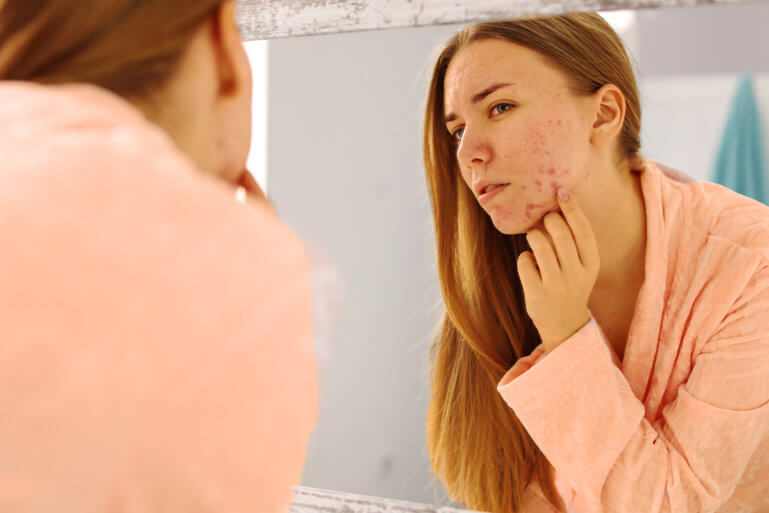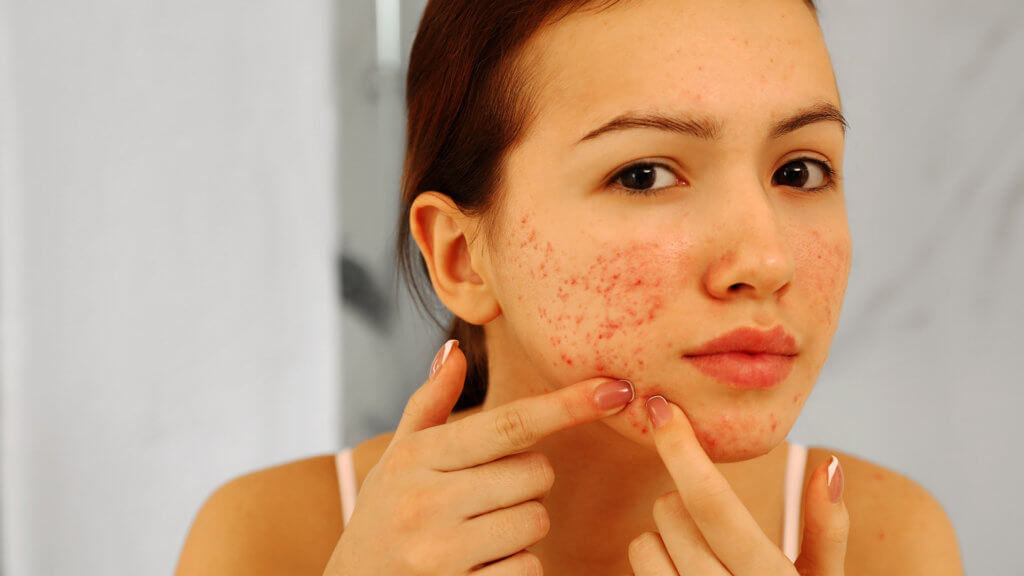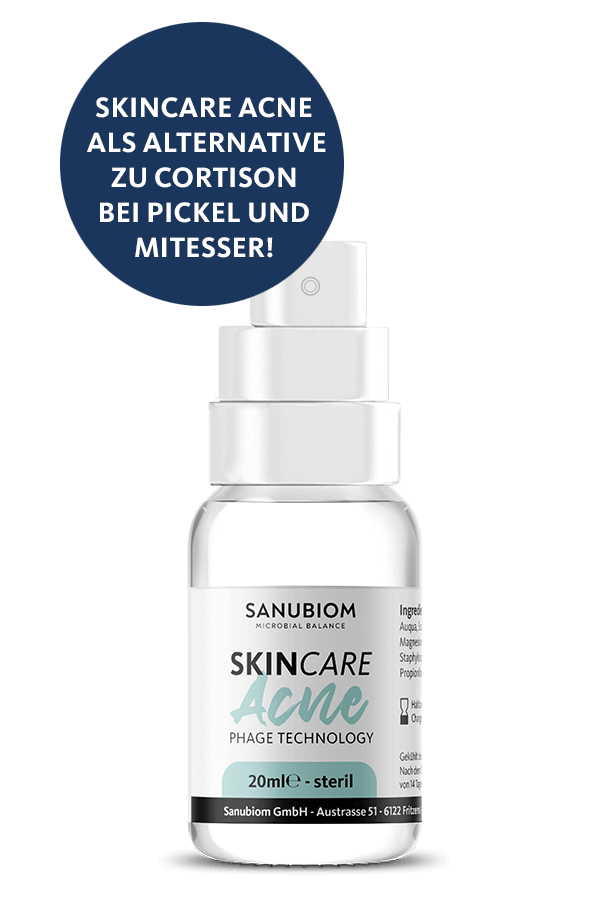Acne

Acne tarda, also known as late acne or adult acne, refers to the appearance of acne in individuals who have entered adulthood beyond the teenage years. While acne is usually associated with adolescence, it can also occur later in life, typically in people aged 25 and over. Acne tarda has similar characteristics to adolescent acne, including the formation of comedones (blackheads and whiteheads), papules, pustules and, in some cases, nodules and cysts.
When does acne tara occur?
Comparison between puberty acne and late acne
Late acne causes
Consequences of acne tarda
Treatment of late acne
Frequently asked questions about late acne
Acne in adults is a common concern: Expert estimates suggest that up to 40% of people over the age of 25 suffer from blemished skin with a tendency to acne on the face, back, neck or décolleté, with 75-85% of these cases affecting women.
Late acne, also known as acne tarda, develops in a similar way to puberty acne with microcomedones, the preliminary stages of blackheads. Inflammatory papules and pustules may also form. Compared to teenage acne, the skin tends to be drier with late acne and forms more pimples and inflammations, especially on the lower half of the face. At the same time, seborrhea (excessive sebum production) and hyperkeratosis (excessive keratinization) lead to clogged pores and comedones, which trigger bacterial colonization and inflammatory processes, resulting in further pimples and pustules.
Many women also show signs of blemished skin after stopping the pill, during pregnancy or during the menopause. Although the symptoms of late acne are often only mild to moderate, those affected experience similar suffering to younger patients, as pimples are often perceived as a blemish in adulthood. In addition, the first wrinkles appear, which can have an impact on the psyche and self-confidence. However, careful skin care with suitable products can help to reduce the symptoms, refine the skin’s appearance and at the same time combat late acne and wrinkles.
The causes of late acne are varied and have not yet been conclusively researched. Various factors can contribute to the development of acne tarda, and there is often a combination of several causes. However, it is assumed that hormones and hormonal fluctuations play a role. Other influencing factors can be genetic predisposition, tobacco consumption, cosmetics and stress. Here are some of the main causes:
A common trigger of acne tarda is a hormonal imbalance in the body. Late acne affects women more often than men, which may be related to the more frequent hormonal fluctuations that occur during the menstrual cycle, when stopping the pill, during pregnancy and during the menopause. In women, this can be caused by fluctuations in the menstrual cycle, pregnancy or the onset of the menopause. In men, hormonal changes with age can also lead to late acne. These hormonal fluctuations can also trigger acne in adults.
Stress plays a significant role in skin problems, including acne tarda. A hectic lifestyle, professional pressure and personal challenges can affect hormone levels and thus cause or worsen acne. Stress is also considered an important factor in adult acne, as the body produces hormones under stress that lead to increased horn cell and sebum production.
Nutrition plays a decisive role in skin health. An unbalanced diet rich in fatty and sugary foods can increase sebum production and thus promote the appearance of acne tarda.
Using skin care products that are too rich or too aggressive can clog pores and lead to acne. It is important to pay attention to the needs of your own skin and select products accordingly.
Certain medications, including steroids, antidepressants and hormonal drugs, can increase the risk of acne tarda. It is advisable to speak to a doctor if there is any suspicion of a connection.
The health of the digestive system and intestinal flora can also have an effect on the skin. Impaired intestinal flora can promote inflammation in the body, which affects the skin.

The consequences of adult acne can be divided into visible and psychological aspects. After the disease has subsided, scars or pimple marks may remain on the skin. Psychologically, people with late acne can suffer more frequently from depression, anxiety and social phobia. Blemished skin can affect self-image, which can lead to avoidance behavior in social situations.
As with most consequences of acne, the effects of adult acne can be divided into two main categories: the physical, visible effects and the psychological, invisible effects.
After the actual disease has subsided, acne scars or pimple marks (post-inflammatory hyperpigmentation) may remain on the skin. It is advisable to consult a doctor at an early stage to prevent the formation of scars and marks.
The emotional stress caused by acne in adulthood is significant. Studies show that people with late acne are more likely to suffer from depression, anxiety and social phobia. Many adults with acne avoid looking in the mirror, and the presence of blemished skin often makes them uncomfortable in company.
The treatment of acne tarda requires a comprehensive approach. Consult a dermatologist to discuss the best options for your individual situation. This could include medication, skin care and possibly lifestyle changes. Here is some more detailed information on the different aspects of acne tarda:

SKINCARE ACNE
Probiotic skin protection SkinCare Acne with Phage Technology.
Your skin comes to rest.
Retinoids: These topical medications are derivatives of vitamin A and can help regulate sebum production and clear clogged pores. However, their use requires careful monitoring as they can make the skin more sensitive.
Antibiotics: Antibiotics can help fight inflammatory forms of acne by reducing the bacteria. They are often prescribed in combination with other medications to increase their effectiveness.
Hormone therapy: Women can benefit from oral contraceptives that regulate hormones and thus balance the hormonal imbalance that contributes to acne tarda. Antiandrogens can also be used to reduce the influence of male hormones.
Choosing the right skincare products is crucial to soothe the skin and control sebum production. Products with salicylic acid, glycolic acid or niacinamide can help control acne and promote a healthy skin barrier.
Targeted skin care with special products can help to reduce the symptoms of acne tarda and improve the appearance of the skin. Thorough cleansing that removes excess sebum is important, and mature skin needs gentle, moisturizing cleansing. The right care, such as a moisturizing cream against late acne, should have a light texture and be non-comedogenic. When applying skin care products, the strongest product should be applied first, usually a light cream or serum.
Consistently avoiding unhealthy lifestyles and unsuitable cosmetics can help to improve acne in adulthood. If necessary, a cleansing scrub can be used instead of a cleansing gel to open clogged pores. A concealer can be used to cover affected areas and products with salicylic acid can help to prevent blackheads from forming.
Stress management: Techniques such as meditation, breathing exercises and regular breaks can help to reduce the stress that can contribute to worsening acne tarda.
Diet: A balanced diet with plenty of fruit, vegetables, wholegrain products and sufficient water can support skin health. Avoid sugary foods and fatty foods that can promote inflammation.
Physical activity: Regular exercise promotes blood circulation and helps to detoxify the body. This can have a positive effect on skin health.
Chemical peels: By applying chemical solutions to the skin, dead skin cells can be removed, resulting in clear and radiant skin.
Laser therapy: Laser treatments can reduce inflammation, stimulate collagen production and improve the appearance of the skin.
Microdermabrasion: This method mechanically removes dead skin cells and promotes the formation of new, healthy skin
The treatment of acne tarda requires an individual approach. A dermatologist will make an accurate diagnosis and recommend a customized treatment strategy, which may include a combination of different therapies.
The duration of acne tarda can vary. Some people see improvements after just a few weeks of treatment, while others may take longer. Continuity of treatment and adaptation according to need are crucial.
There are many creams and topical treatments that can help with acne tarda. Products with ingredients such as benzoyl peroxide, salicylic acid, retinoids or niacinamide can alleviate the symptoms and improve the appearance of the skin. It is important to choose the right products for your skin type and to use them regularly.
Author: Martin Müller
“Various internal and external influences can cause our microbial balance to become unbalanced. Harmful bacteria get out of hand and skin irritations such as redness, itching and eczema are the result. “
Share post: